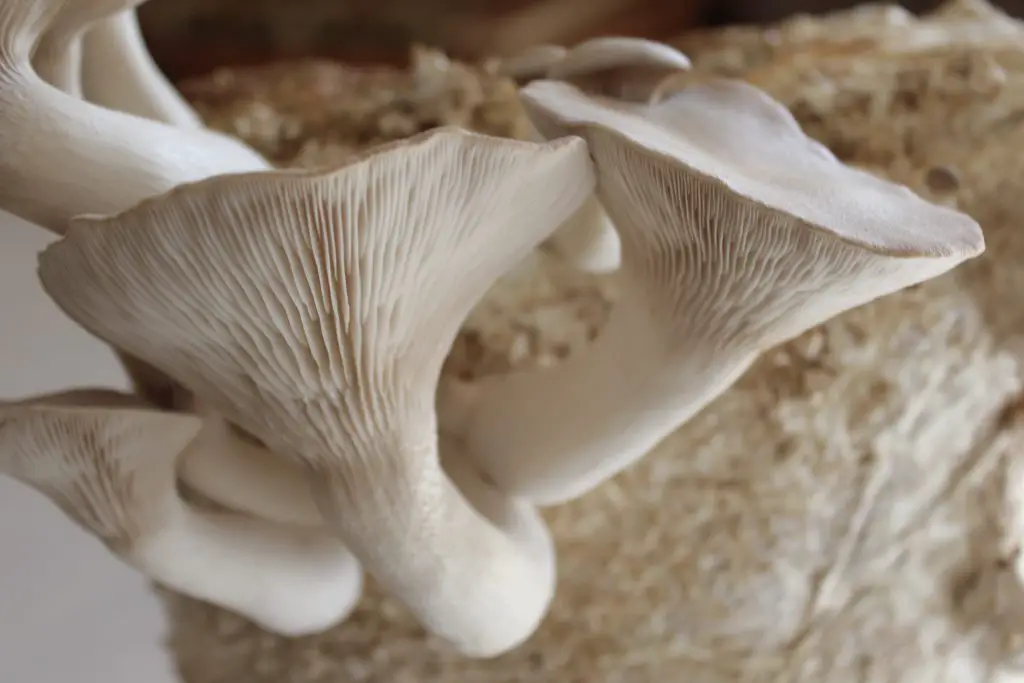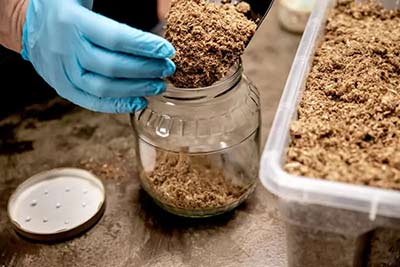To cultivate mushrooms, it’s necessary to cultivate them in a certain environment. The substrate is used to make those conditions and before use, you need to sterilize substrate. This article will share how to sterilize mushroom substrate without a pressure cooker.
Contents
About Mushroom Cultivation
Mushroom cultivation at home has been a growing trend. Mushrooms are versatile and can be used in multiple ways, it is a fun and very useful thing to grow at home. For proper cultivation, certain environmental conditions must be met.
For mushrooms, you need a substrate as play needs soil. The substrate provides the mushrooms with their nutrients and moisture via the mycelium. You can use the following items as a substrate:
- Straw
- Coffee grounds
- Coco coir
- Wood chips
Before using these items as a substrate, you need to sterilize them properly as contamination is the most common cause of failure among home mushroom growers. With proper sterilization, you can kill any mold, other fungi, bacteria, or viruses that might impact mushroom cultivation.
How To Sterilize Mushroom Substrate Without A Pressure Cooker?
Before using any of the methods discussed here, it is important to sterilize all working surfaces with alcohol sanitizers. The five effective techniques for sterilization are as follows:
- Chemical Sterilization
- Hot water immersion
- Composting
- Tyndallization
- Pasteurization
1. Chemical Sterilization
Many people prefer chemical sterilization as it’s relatively cheaper than the other option plus this process requires no heat. But, it can be hazardous so it’s necessary to be equipped with safety protocols. There are two main options for chemical sterilization, hydrated lime, and hydrogen peroxide.
A) Hydrated Lime:
Hydrated lime is a white powder that is produced by adding water to quicklime to create calcium hydroxide. It is commonly used as a soil amendment or pH adjuster. The lime you use makes sure it has a magnesium content of less than 2% and a higher calcium concentration.
Now follow these steps to sterilize properly;
- Prepare the substrate – Cut the substrate into long pieces that are about an inch in diameter. If you are using straw, make sure to chop it into small pieces.
- Mix the hydrated lime and water – In a clean bucket, mix 0.2 g of hydrated lime for every gallon (4 liters) of water. Make sure to stir the mixture until the lime has completely dissolved. It is ideal to mix 300 g of lime with 55 gallons of water.
- Add the substrate – Once the lime and water have been mixed, add your substrate to the bucket. Stir until all of the pieces are coated with the mixture.
- Allow the substrate to soak – Leave the bucket of the substrate to soak for 24 hours. This will allow the lime to kill any contaminants that might be present on the substrate.
- Drain and rinse the substrate – After soaking, drain and rinse the substrate with clean water. Make sure to remove as much of the lime mixture as possible.
- Dry the substrate – Once the substrate has been rinsed, spread it out on a clean surface and allow it to air dry. Once it’s dry, it will be ready to use for mushroom cultivation.
B) Hydrogen Peroxide:
Hydrogen peroxide is a chemical compound that is made up of water and oxygen. It is a powerful oxidizer and can be used as a disinfectant or bleaching agent.
To sterilize substrate with hydrogen peroxide, follow these steps:
- Gather 3% Hydrogen Peroxide.
- Add the substrate in one gallon of water. After 20 minutes leave the water to dry.
- Spill one liter of 3% hydrogen peroxide on the liquid solution.
- Let substrate be submerged in a water and hydrogen peroxide mixture for a day.
- After that displace the substrate from the mixture and rinse it with water twice.
- After cleaning, inoculate the substrates.
2. Hot Water Immersion Scalding Process
This method is most commonly used as it’s quick and effective. The hot water will kill any mold, bacteria, or viruses that might be present on the substrate. Keep the substrate soaked in hot water for more than 1 to 5 hours. To sterilize substrate using this method, follow these steps:

- Prepare The Substrate – Cut the substrate into small pieces that are about an inch in diameter. If you are using straw, make sure to chop it into small pieces.
- Bring The Water To A Boil – In a large pot, bring enough water to cover the substrate. Once the water has come to a boil, reduce the heat and allow it to simmer.
- Add The Substrate To The Water – Once the water has come to a simmer, add the substrate to the pot. Stir until all of the pieces are submerged in the water.
- Simmer For 1-5 Hours – Allow the substrate to simmer in the water for 1-5 hours. This will kill any contaminants that might be present on the substrate.
- Drain And Rinse The Substrate – After simmering, drain and rinse the substrate with clean water. Make sure to remove as much of the water as possible.
- Inoculate the sterilized substrate – Now inoculate the dried substrate. it would be wise of you to ensure that the spawn rate is below 5%. Collect the substrate and place them in the growing chamber
3. Composting Process
Composting is a great way to sterilize substrate without using any chemicals. The process of composting will kill any mold, bacteria, or viruses that might be present on the substrate. To compost substrate, follow these steps:
- Gather The Materials – Gather all the mushroom substrate that you planned to utilize. Create a pile of your mushroom substrate in a suitable area.
- Moisturise The Substrate – Mix water and substrate properly that it has 70% moisture. This mixing process will last for 7 days while being careful that the pile does not overheat. If the substrate is not moisturized, hot spots might grow. The pile of substrate will heat up to 60 to 70 degrees.
- Store The Moisturized Substrate Into Tunnels – After 7 days, store the moisturized substrate into tunnels. The tunnels should be 8 to 10 inches in diameter. Make sure that the substrate is not too tightly packed into the tunnel. Now seal the tunnel with breaks and let it heat up.
- Keep The Temperature Within The Tunnel To 65 Degrees For 18 Hours – Use a thermometer to keep track of the temperature inside the tunnel. This process will kill any contaminants that might be present on the substrate. This process is known as pasteurization.
- Lower The Temperature To 48 Degree – After 18 hours, lower the temperature to 48 degrees. This will help the substrate to colonize.
- Lower The Temperature To 25 Degree – After the substrate has colonized, lower the temperature to 25 degrees. This will help the substrate to fruit.
- Inoculate the Substrate – Now that the substrate has been sterilized, you can inoculate it with your desired mushrooms. Make sure to use a spawn rate of below 5%. Collect the substrate and place them in the growing chamber.
4. Tyndallization Process of Sterilization
Tyndallization is a process of sterilization that uses heat and humidity. To Tyndall substrate, follow these steps:

- Prepare the chopped substrates in bags.
- Place the bags in a container
- Provide heat exposure and raise the temperature to 100°C. You have to keep It at 100 degrees for one hour.
- For the next day, you have to keep the temperature to 25 degrees.
- Then repeat step 2 and step 3 thrice.
5. Pasteurization Process of Sterilization
Pasteurization is a process of sterilization that uses heat. Substrates need to be kept at 60-80°C, for at least 5 days. To pasteurize substrate, follow these steps:
- Gather The Materials – Gather all the mushroom substrate that you planned to sterilize. Create a pile of your mushroom substrate in a suitable area and seal them in bags.
- Heat The Water – Provide maximized heat to the water, heat till the temperature reaches 100 degrees.
- Place The Bags On A Barrel With Heat Exposure – After the water has reached 100 degrees, carefully place the bags of substrate on the barrel. Make sure that the bags are not touching each other. This process will continue for 15 to 18 hours
- Cool Down – Take the bags away from the barrel. Then keep it in a cool place to decrease its temperature for 24 hours to decrease the temperature to 28 degrees.
- Ready – Now that the substrate has been sterilized, you can inoculate it or store them safely.
Do you have to pressure cook mushroom substrate?
No, you don’t have to pressure cook mushroom substrate. There are other methods for sterilization that don’t require a pressure cooker. Both of these methods use heat to sterilize the substrate and kill any contaminants that might be present.
Although, pressure cookers are a very helpful tool and can save you a lot of time. If you choose to pressure cook your substrate, make sure to follow all the safety instructions that come with the pressure cooker.
How long should you sterilize mushroom substrate?
The length of time that you should sterilize your mushroom substrate will depend on the method of sterilization that you choose to use. If you choose to pressure cook your substrate, you should sterilize it for at least 2 hours.
If you choose to tyndallize your substrate, you should sterilize it for at least 3 days. And if you choose to pasteurize your substrate, you should sterilize it for at least 5 days.
What is the best way to sterilize mushroom substrate?
There is no one “best” way to sterilize mushroom substrate. The method that you choose should be based on your personal preferences and the resources that you have available.
Some methods, such as pressure cooking, are very time-consuming, while other methods, such as pasteurization, take longer but maybe less work in the long run. Ultimately, the best way to sterilize your mushroom substrate is the way that works best for you.
What can I do with an old mushroom substrate?
If you have an old mushroom substrate that you no longer want to use, there are a few things that you can do with it. You can either compost it, use it as mulch, or simply throw it away. If you choose to compost it, make sure to mix it in with other organic materials such as leaves and grass clippings.

If you choose to use it as mulch, spread it around the base of your plants. This will help to retain moisture and keep weeds at bay. And if you choose to throw it away, make sure to dispose of it responsibly.
How To Sterilize Mushroom Substrate Without A Pressure Cooker – Conclusion
This article shared how to sterilize mushroom substrate without a pressure cooker. Additionally, you should check the pressure cooker used as an autoclave.. The mushroom substrate must be sterilized before it can be used for growing mushrooms. There are a few different methods that can be used to sterilize substrates, such as pressure cooking, tyndallization, and pasteurization.
The method that you choose should be based on your personal preferences and the resources that you have available. Ultimately, the best way to sterilize your mushroom substrate is the way that works best for you.
Reference
- https://www.seriouseats.com/how-pressure-cookers-work
- http://www.conscientiabeam.com/ebooks/7-4thICETSR-506-2015-(45-51).pdf
- https://learn.freshcap.com/growing/using-pressure-cookers-for-growing-mushrooms/
Amazon and the Amazon logo are trademarks of Amazon.com, Inc, or its affiliates.

